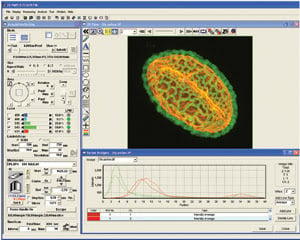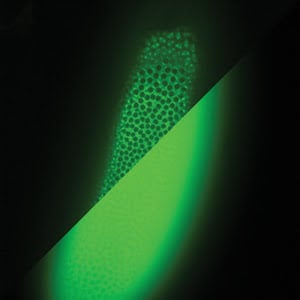Nicolas George, Olympus America Inc.
When imaging thick biological specimens, light from out-of-focus planes often obscures the fluorescence of structures of interest. Various confocal methods can remove out-of-focus light to reveal the structures. Different confocal systems allow biologists to balance two sometimes incompatible priorities — rejecting as much unwanted light as possible while maintaining a detectable signal and perhaps a viable specimen.
In laser scanning confocal systems, point laser excitation and the emission pinhole combine to remove most out-of-focus light. The excitation laser source scans across the specimen in a point-by-point raster pattern to form a complete image of the focal plane, and often a series of sections taken through the specimen are reconstructed and displayed in three dimensions.
Laser scanning confocal microscopes offer advantages, particularly in imaging thick cells with a high density of intracellular components. These instruments allow extremely thin optical sectioning of specimens, enabling structures and intracellular features deep within the specimen to be viewed, and the laser provides a very intense, small spot of light that can easily be used for purposes other than imaging, such as photobleaching and molecular uncaging. For instance, the Fluoview FV1000 SIM system offers two scan heads: One allows photoactivation or bleaching, and the other simultaneously collects the image.
Laser-based confocal systems are ideal for researchers who need a high degree of confocality. Because the instruments use very small apertures and reject a great deal of light, they require high-intensity excitation sources, objectives with high numerical apertures and specimens that emit bright signals.
The point acquisition requires point detectors, and photomultiplier tubes are only 30 to 50 percent efficient at converting light energy into a detectable signal. The point-by-point image acquisition can capture the thinnest obtainable sections but at the expense of speed. The system may take between 0.3 and 1.0 s to capture a 1024 × 1024-pixel image and may miss a burst of light that lasts only 0.1 s.
Because of the time required to acquire not only one plane, but the entire stack of planes, the laser scanning confocal system typically is used with specimens that don’t move during image acquisition (Figure 1). Movement during the scan produces images with jagged edges and with poor definition of intracellular details. Still, laser scanning confocal microscopes are probably the most widely used confocal systems in life sciences research today.

Figure 1. Laser scanning confocal microscopes work well with samples that don’t move, such as the pollen grain seen in this screen shot. Images courtesy of Olympus America Inc.
Spinning disk confocal systems
As an alternative, some researchers use spinning disk confocal systems, which offer much greater light throughput but somewhat diminished confocality. These systems use a rotating disk with a pattern of slits or holes installed in a microscope plane that is conjugate with the specimen. The opaque areas of the disk block out-of-focus light from both the excitation and emission light paths.
This confocal method is popular for applications that require fast image acquisition. However, the systems’ larger pinhole or slit openings cannot deliver optical sections with the same thinness as those that are provided by their laser-based cousins. Compared with laser scanning systems, confocal systems offer the benefit of reduced toxicity to specimens during time-lapse imaging of living cells.
There are two principal types of spinning disks. Nipkow disk systems provide good confocality and improved throughput, but their pinholes do not permit as much light transmission as some experiments require. The Yokogawa modification to this system adds a second disk of microlenses to focus the excitation light and to improve transmission efficiency. Typically configured with laser sources, these systems are limited in their excitation wavelengths based on the laser lines installed.
Olympus recently introduced the DSU disk scanning confocal microscope as an alternative. With proprietary, patent-pending disk technology, this system delivers optical sectioning capabilities similar to those of a Nipkow disk system with greater light throughput by using a disk consisting of a pattern of slits (as opposed to pinholes). It has five easy-to-change disks of varying slit widths, each matching an objective’s numerical aperture, magnification and specimen thickness.
Disk operation is fully motorized to allow computer switching between confocal and wide-field imaging. The high transmission allows a white-light mercury or xenon arc lamp to be used, and wavelength selection is accomplished with standard filter sets. The optical design delivers good near-UV performance down to 340 nm. The system offers full-frame CCD image capture at 15 to 20 fps. The choice of disks allows confocal observation using 103 to 1003 objectives as well as imaging of fluorochromes excited with near-UV to near-IR light.
A popular application is live-cell observations by mounting the spinning disk confocal module on a motorized microscope (Figure 2), usually one with a built-in Z-axis drive to allow 3-D imaging.

Figure 2. This comparison image of a larval Drosophila melanogaster, or fruit fly, was captured using a 20× objective with wide-field fluorescence (below diagonal line) and using the DSU spinning disk confocal system (above diagonal line).
Scientists are always pushing the limits of their microscopes into new and exciting areas of research. The wide range of confocal microscope designs is evidence of their need to balance the desire to remove the greatest amount of out-of-focus light, while maintaining a detectable signal and minimizing cell phototoxicity and fluorochrome bleaching.
Meet the author
Nicolas George is manager of microscope systems at Olympus America Inc. in Melville, N.Y.; e-mail: [email protected].